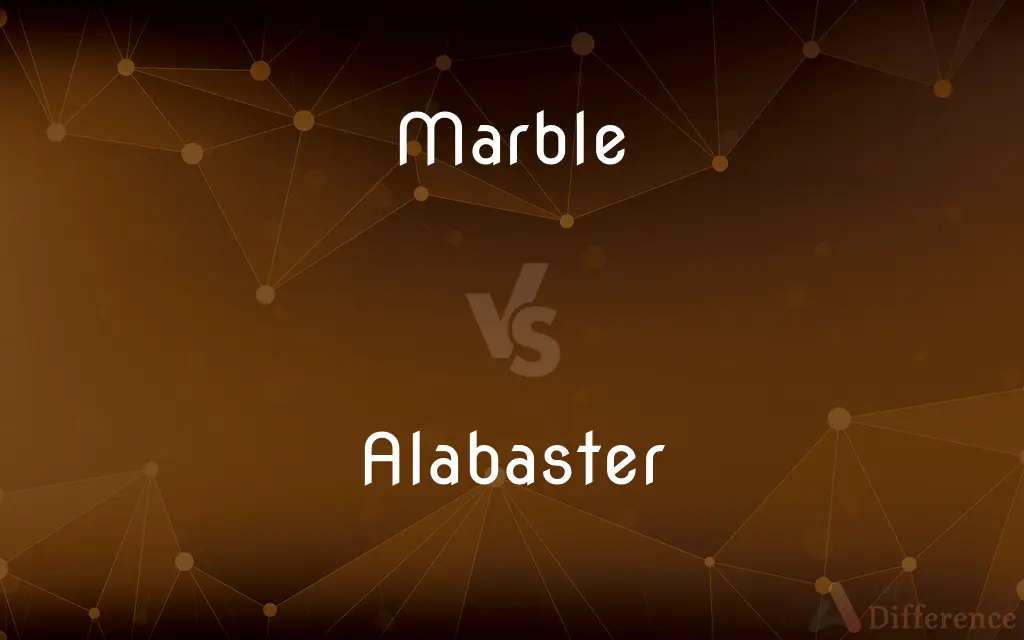Marble vs. Alabaster — What's the Difference?
By Tayyaba Rehman — Updated on October 11, 2023
Marble is a metamorphic rock derived from limestone; Alabaster is a soft, fine-grained sedimentary rock often used for carving.

Difference Between Marble and Alabaster
Table of Contents
ADVERTISEMENT
Key Differences
Marble and Alabaster are both naturally occurring stones that have been utilized throughout history for various artistic and architectural purposes. Marble, a metamorphic rock, is formed when limestone undergoes heat and pressure over time. Its veined patterns, combined with its durability, make Marble a popular choice for sculptures, flooring, and countertops. Alabaster, on the other hand, is a sedimentary rock, typically white or lightly colored, which is softer and more translucent than Marble.
While Marble boasts a wide array of colors and patterns, lending to its unique appearance in every piece, Alabaster's main attraction is its softness, which makes it easier to carve. Artists often choose Alabaster for intricate carvings or when seeking a luminous effect, as light can pass through the stone, creating a glowing appearance. Despite Alabaster's allure for carving, its softness can be a drawback, making it less suitable for high-traffic areas or surfaces that require durability.
In terms of historical significance, Marble has been widely used in ancient architectures, notably in Greek and Roman structures. Its resilience and timeless beauty make it a preferred material for monumental works. Alabaster's history is also rich, with its use dating back to ancient civilizations like Egypt, where it was employed for making vases and other artifacts, leveraging its carvability.
Another interesting comparison between Marble and Alabaster lies in their geological formation. While Marble forms from the metamorphism of limestone, usually due to tectonic plate movements, Alabaster is created when water evaporates from clay-rich beds, leaving the gypsum behind. This difference in formation contributes to the distinct characteristics observed in both stones.
Comparison Chart
Type of Rock
Metamorphic
Sedimentary
ADVERTISEMENT
Hardness
Hard and durable
Soft and carvable
Translucency
Generally opaque
Often translucent
Formation
From limestone under heat & pressure
From evaporating water in clay-rich beds
Typical Use
Sculptures, flooring, countertops
Intricate carvings, luminous pieces
Compare with Definitions
Marble
Known for its veined patterns and various colors.
The Marble countertop added an elegant touch to the kitchen.
Alabaster
A rock that can be translucent, allowing light to pass.
Light shone through the Alabaster, creating a mesmerizing effect.
Marble
A material used in architecture and art for centuries.
Ancient Greeks used Marble extensively in their temples.
Alabaster
Typically white or lightly tinted.
The Alabaster vase radiated a gentle glow.
Marble
To mottle or streak, giving a marbled appearance.
The cake had a marbled effect with chocolate and vanilla.
Alabaster
A term denoting a smooth, white skin complexion.
Her Alabaster skin contrasted beautifully with her dark hair.
Marble
Marble is a metamorphic rock composed of recrystallized carbonate minerals, most commonly calcite or dolomite. Marble is typically not foliated, although there are exceptions.
Alabaster
Alabaster is a mineral or rock that is soft, often used for carving, and is processed for plaster powder. Archaeologists and the stone processing industry use the word differently from geologists.
Marble
A metamorphic rock formed by alteration of limestone or dolomite, often irregularly colored by impurities, and used especially in architecture and sculpture.
Alabaster
A dense, translucent, white or tinted fine-grained gypsum.
Marble
A piece of this rock.
Alabaster
A variety of hard calcite, translucent and sometimes banded.
Marble
A sculpture made from this rock.
Alabaster
A pale yellowish pink to yellowish gray.
Marble
Something resembling or suggesting metamorphic rock, as in being very hard, smooth, or cold
A heart of marble.
A brow of marble.
Alabaster
A fine-grained white or lightly-tinted variety of gypsum, used ornamentally.
Marble
A small hard ball, usually of glass, used in children's games.
Alabaster
(historical) A variety of calcite, translucent and sometimes banded.
Marble
Marbles (used with a sing. verb) Any of various games played with marbles.
Alabaster
(color) An off-white colour, like that of alabaster.
Marble
Marbles Slang Common sense; sanity
Completely lost his marbles after the stock market crash.
Alabaster
Made of alabaster.
The crown is stored in an alabaster box with an onyx handle and a gold lock.
Marble
Marbling.
Alabaster
Resembling alabaster: white, pale, translucent.
An ominous alabaster fog settled in the valley.
Marble
To mottle and streak (paper, for example) with colors and veins in imitation of marble.
Alabaster
A compact variety or sulphate of lime, or gypsum, of fine texture, and usually white and translucent, but sometimes yellow, red, or gray. It is carved into vases, mantel ornaments, etc.
Marble
Composed of metamorphic rock
A marble hearth.
Alabaster
A box or vessel for holding odoriferous ointments, etc.; - so called from the stone of which it was originally made.
Marble
Resembling metamorphic rock in consistency, texture, venation, color, or coldness.
Alabaster
A compact fine-textured usually white gypsum used for carving
Marble
A metamorphic rock of crystalline limestone.
Alabaster
A hard compact kind of calcite
Marble
A small ball used in games, originally of marble but now usually of glass or ceramic.
Alabaster
A very light white
Marble
Statues made from marble.
The Elgin Marbles were originally part of the temple of the Parthenon.
Alabaster
A soft, fine-grained sedimentary rock used for carving.
The artisan chose Alabaster for its ease of carving.
Marble
(transitive) To cause (something to have) the streaked or swirled appearance of certain types of marble, for example by mixing viscous ingredients incompletely, or by applying paint or other colorants unevenly.
Alabaster
Historically used in ancient civilizations for artifacts.
Ancient Egyptians often used Alabaster for ornate vases.
Marble
(intransitive) To get or have the streaked or swirled appearance of certain types of marble, for example due to the incomplete mixing of viscous ingredients, or the uneven application of paint or other colorants.
Marble
(transitive) To cause meat, usually beef, pork, or lamb, to be interlaced with fat so that its appearance resembles that of marble.
Marble
To become interlaced with fat; (of fat) to interlace through meat.
Marble
To lace or be laced throughout.
Marble
Made of, or resembling, marble.
A marble mantel
Marble paper
Marble
(figurative) Cold; hard; unfeeling.
A marble heart
Marble
A massive, compact limestone; a variety of calcite, capable of being polished and used for architectural and ornamental purposes. The color varies from white to black, being sometimes yellow, red, and green, and frequently beautifully veined or clouded. The name is also given to other rocks of like use and appearance, as serpentine or verd antique marble, and less properly to polished porphyry, granite, etc.
Marble
A thing made of, or resembling, marble, as a work of art, or record, in marble; or, in the plural, a collection of such works; as, the Arundel or Arundelian marbles; the Elgin marbles.
Marble
A little ball of glass, marble, porcelain, or of some other hard substance, used as a plaything by children; or, in the plural, a child's game played with marbles.
Marble
Made of, or resembling, marble; as, a marble mantel; marble paper.
Marble
Cold; hard; unfeeling; as, a marble breast or heart.
Marble
To stain or vein like marble; to variegate in color; as, to marble the edges of a book, or the surface of paper.
Marble
A hard crystalline metamorphic rock that takes a high polish; used for sculpture and as building material
Marble
A small ball of glass that is used in various games
Marble
A sculpture carved from marble
Marble
Paint or stain like marble;
Marble paper
Marble
A metamorphic rock derived from limestone.
The statue was carved from a single block of Marble.
Marble
A game piece used in the game of marbles.
He lost his favorite Marble during the game.
Common Curiosities
Is Alabaster good for outdoor sculptures?
Alabaster is softer and can be weathered easily, so it's less ideal for outdoor pieces compared to Marble.
Why is Marble commonly used for countertops?
Marble is durable, resistant to heat, and offers unique veined patterns, making it aesthetically pleasing.
Can you see through Alabaster?
Alabaster can be translucent, allowing light to pass through, creating a luminous effect.
What type of rock is Marble?
Marble is a metamorphic rock derived from limestone.
How do Marble and Alabaster differ in appearance?
Marble has veined patterns and can vary in color, while Alabaster is typically white or lightly tinted and can be translucent.
How should Alabaster artifacts be maintained?
Alabaster should be kept away from direct sunlight and cleaned with a soft cloth to maintain its beauty.
Is Alabaster harder than Marble?
No, Alabaster is softer than Marble.
Where does Alabaster get its name?
It's believed to be derived from the Egyptian city of Alabastron, known for its Alabaster vases.
How is the game of marbles related to the Marble stone?
The game pieces, or "marbles," were historically made from the Marble stone, hence the name.
Is Alabaster a good choice for kitchen countertops?
Due to its softness, Alabaster is less suitable for surfaces like countertops compared to harder stones like Marble.
Why was Marble popular in ancient architecture?
Its resilience, timeless beauty, and variety made it a preferred material for monumental structures.
Does Marble only come in white?
No, Marble can come in various colors, including black, green, red, and more, depending on the minerals present.
Are all Marble colors natural?
Yes, the colors and patterns in Marble are naturally occurring due to the minerals present during its formation.
Share Your Discovery

Previous Comparison
Antiserum vs. Vaccine
Next Comparison
Therapy vs. TreatmentAuthor Spotlight
Written by
Tayyaba RehmanTayyaba Rehman is a distinguished writer, currently serving as a primary contributor to askdifference.com. As a researcher in semantics and etymology, Tayyaba's passion for the complexity of languages and their distinctions has found a perfect home on the platform. Tayyaba delves into the intricacies of language, distinguishing between commonly confused words and phrases, thereby providing clarity for readers worldwide.
















































